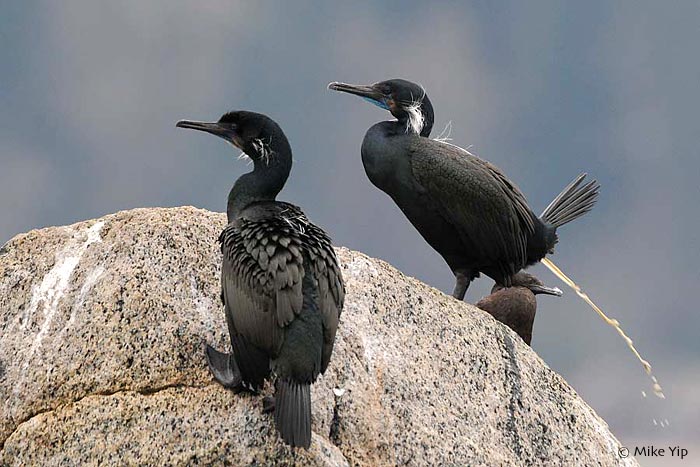
If I only had a dollar for every time I’ve seen the confusion in the spelling of Brandt’s and Brant, I might be able to afford my dream birding trip to Ecuador. Right now we are nearing the end of the Brant Goose migration from Baja, Mexico to the Yukon and Alaska. Many of the Brant stage in the Parksville region to replenish their fat reserves on eelgrass and herring roe before they carry on to their nesting grounds. On the other hand, the Brandt’s Cormorant (Phalacrocorax penicillatus) is a common year-round resident around the west coast and Vancouver Island.

Identifying the Brandt’s Cormorant
There are three species of cormorants on Vancouver Island: Double-crested, Pelagic, and Brandt’s. The Pelagic is the smallest at about 71 cm (28 in) long. The Double-crested is next at 84 cm (33 in) and the Brandt’s is the largest at 86 cm (34 in). The Brandt’s and Double-crested are similar in size but can easily be distinguished from each other. The Brandt’s has a dark bill versus the orangey-yellow bill of the Double-crested.
Besides being the largest cormorant, the Brandt’s has two other distinguishing features. First, it has pale, buffy feathers on its chin just under the eyes. Second, its breeding plumage features white feathering off the side of the head as well as a remarkable light blue gular patch on its chin. The Brandt’s is now molting into its breeding plumage, and this is a great time to see all three species in their breeding finery. In fact, I made a point of visiting Campbell River last week just to photograph the Brandt’s with its sexy blue gular patch.

Breeding Behaviour of the Brandt’s Cormorant
It won’t be long now before the breeding hormones kick in and the males start looking for their mates. Just like male humans the male cormorants try to entice the females with gifts. Instead of diamonds or other high-priced trinkets, the cormorants rely on practical earthly goods like seaweed and grass for nesting material. If the female likes her suitor she accepts the gift and starts building the nest while the male gathers more material.
The Brandt’s usually nest on the outer coast on steep hillsides or cliffs. A great place to see the nesting activity in action is along the Oregon coast. In late May last year at Maquina Head conservation area, I had a great time photographing the Brandt’s Cormorants as they flew right in front of me mouthfuls of grass, and just below there were many nests in between the thousands of Common Murres. I would love to go back some time later in the summer to see the nestlings.
The Brandt’s is a deep-diving bird. It catches fish at all levels, but it often feeds on fish, shrimp, and crabs on the bottom as far as 150 feet down. Like other cormorants, its feathers are designed to water-log to assist in the diving. After the diving it is not uncommon to see the cormorants on the rocks with their wings hung out to dry.
If you want to see the Brandt’s and other cormorants, don’t wait too long. The best place to look is on the rocks at high tide along the shoreline just south of Campbell River. They’ll soon be heading for their nesting grounds.
About the Contributor:
Mike Yip is a Vancouver Island photographer who has published two very successful books on birds and has just released his third. More of his bird images can be found at his website Vancouver Island Birds.